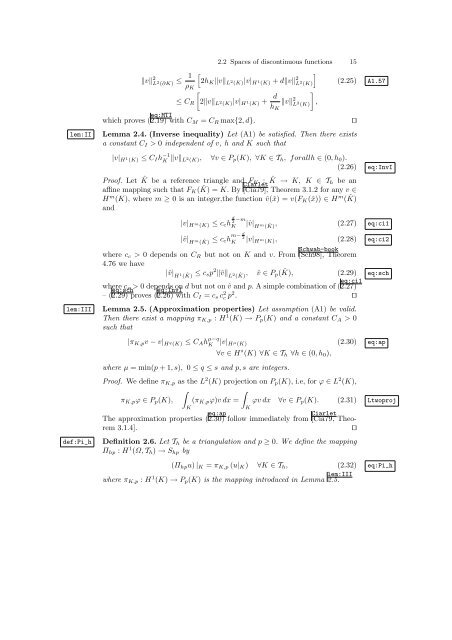2 DGM for elliptic problems
2 DGM for elliptic problems
2 DGM for elliptic problems
Create successful ePaper yourself
Turn your PDF publications into a flip-book with our unique Google optimized e-Paper software.
lem:II<br />
lem:III<br />
def:Pi_h<br />
2.2 Spaces of discontinuous functions 15<br />
‖v‖ 2 L 2 (∂K) ≤ 1 [<br />
]<br />
2h K ‖v‖ L<br />
ρ 2 (K)|v| H 1 (K) + d‖v‖ 2 L 2 (K) (2.25) A1.57<br />
K<br />
[<br />
≤ C R 2‖v‖ L2 (K)|v| H1 (K) + d ]<br />
‖v‖ 2 L<br />
h 2 (K) ,<br />
K<br />
which proves ( eq:MTI 2.19) with C M = C R max{2,d}. ⊓⊔<br />
Lemma 2.4. (Inverse inequality) Let (A1) be satisfied. Then there exists<br />
a constant C I > 0 independent of v, h and K such that<br />
|v| H1 (K) ≤ C I h −1<br />
K ‖v‖ L 2 (K), ∀v ∈ P p (K), ∀K ∈ T h , <strong>for</strong>allh ∈ (0,h 0 ).<br />
(2.26) eq:InvI<br />
Proof. Let ˆK be a reference triangle and F K : ˆK → K, K ∈ Th be an<br />
affine mapping such that F K ( ˆK) = K. By [Cia79], Ciarlet Theorem 3.1.2 <strong>for</strong> any v ∈<br />
H m (K), where m ≥ 0 is an integer,the function ˆv(ˆx) = v(F K (ˆx)) ∈ H m ( ˆK)<br />
and<br />
|v| Hm (K) ≤ c c h d 2 −m<br />
K |ˆv| H m ( ˆK)<br />
, (2.27) eq:ci1<br />
|ˆv| Hm ( ˆK) ≤ c ch m− d 2<br />
K |v| H m (K), (2.28) eq:ci2<br />
where c c > 0 depends on C R but not on K and v. From [Sch98], Schwab-book Theorem<br />
4.76 we have<br />
|ˆv| H 1 ( ˆK) ≤ c sp 2 ‖ˆv‖ L 2 ( ˆK) , ˆv ∈ P p( ˆK), (2.29) eq:sch<br />
where c s > 0 depends on d but not on ˆv and p. A simple combination of ( 2.27)<br />
eq:ci1<br />
– ( 2.29) eq:sch proves ( 2.26) eq:InvI with C I = c s c 2 c p 2 . ⊓⊔<br />
Lemma 2.5. (Approximation properties) Let assumption (A1) be valid.<br />
Then there exist a mapping π K,p : H 1 (K) → P p (K) and a constant C A > 0<br />
such that<br />
|π K,p v − v| H q (K) ≤ C A h µ−q<br />
K |v| H µ (K) (2.30) eq:ap<br />
∀v ∈ H s (K) ∀K ∈ T h ∀h ∈ (0,h 0 ),<br />
where µ = min(p + 1,s), 0 ≤ q ≤ s and p,s are integers.<br />
Proof. We define π K,p as the L 2 (K) projection on P p (K), i.e, <strong>for</strong> ϕ ∈ L 2 (K),<br />
∫<br />
∫<br />
π K,p ϕ ∈ P p (K), (π K,p ϕ)v dx = ϕv dx ∀v ∈ P p (K). (2.31) Ltwoproj<br />
K<br />
The approximation properties ( 2.30) eq:ap follow immediately from [Cia79, Ciarlet Theorem<br />
3.1.4].<br />
⊓⊔<br />
Definition 2.6. Let T h be a triangulation and p ≥ 0. We define the mapping<br />
Π hp : H 1 (Ω, T h ) → S hp by<br />
K<br />
(Π hp u) | K = π K,p (u| K ) ∀K ∈ T h , (2.32) eq:Pi_h<br />
where π K,p : H 1 (K) → P p (K) is the mapping introduced in Lemma 2.5.<br />
lem:III
















